This (170 x 130 mm) notebook has been rebound, the brown leather front cover is original. The front of the notebook has a (74 x 55 mm) label of cream-coloured paper with 'Port Desire — Famine Wollaston Isld Navarin Isd. E. Falkland Isld Measurements of curved hills East coast of Chiloe Boat excursion Chonos S. Carlos' written in ink. There were originally 182 pages written in one sequence. Some of the pages are watermarked 'John Morbey 1830'.
[front cover]
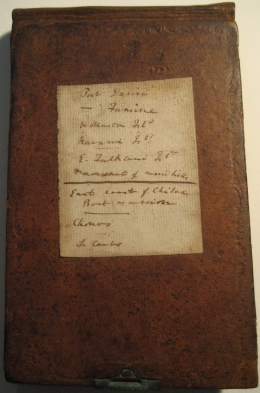
Port Desire
— Famine
Wollaston Isld
Navarin Isd.
E. Falkland Isld
Measurements of curved hills
East coast of Chiloe
Boat excursion
Chonos
S. Carlos
[inside front cover]
C. Darwin
(Capt. one dollar) Smith trousers
<Something was apparently glued to this page, which has been torn away, thereby destroying words in ink>
< > [use] of < > T. del F<uego> < >. exp< > Ponsonby. Sound:— < > or N [by] W Falkland Islands [Gunner] [illeg]
Head — 2 sorts other [species] from [ford] Pebbles Height of N. Plain South Barranca. East Coast.
Structure of gravel at S. Barranca [Gecko] [Craters] Shells low water
R. Chupat: 43º : 20' Calyen 43.10'
492
667
300
285
503
1088
328
667
261
600
[pages 1-2 excised]
[page 3]
½ A Sea 30.328 58. 7
[Plain]30.065 .58
9º
12 ¾
Hill 29.914 57
H. Plain 30.067 57 SW Hill 29.920 6 ½ First
D
— 56 55 56
56 / 10 ¼
30.214 51.5 49.5
Plain Sea 7 ½ 30.492 51.5 49
(Jan 2nd) 1834
328
665
263
492
214
.298 SW Hill ∠ NE Hill ∠ Penguin island ∠ Mouth of Creek
Guanaco Hill
Island
N: 64º 14º 30' 53º10' 84º 43'
122º 30'
[page 4]
Su Both 2 hills same sort of Porphyritic — Plain Barometrically of same height on both sides
(3d) [January 1834]
Plain above cliffs of same formation as generally — I see in many places, that the upper bed, is sand, calcareous, white, A: the next more clayey & yellowish B with salt flavour; this contains layers of fine gypsum — This plain slants down to the cliffs. —
Saw two breccia uncrystallized Porphyry bed dipping to
[page 5]
the Westward // many of the pebbles on the hills white washed.—
Ferruginous Sandstone Coarse as below [like] a specimen White Mortar, silex particles D ? red, white earthy crystals, porphyry dip to WNW
Coarse Ferruginous Sandstone All dip to NW Hard Calc white Sandstone F Calcareo — Feldspathic ? E red as below white (D) Feldspathic rock red jaspery porphyry
[page 6]
(C) occurs amongst & forms great masses [amongst] red Jasper Porph rock Rocks generally resting on a compact hard earthy Feldspar coloring matter of. — Red rock seems to blend with white, making pink —
Dip NW red color sometimes in lines in horizontal section in patches. circular & bands
[page 7]
There are dykes only differing from surrounding rock [by figure] in straight line 2 [illeg] [broad] In all pebbles
There is a bed of conglomerate of bright red colour, usual dip (about 10º) composed of pebbles of red highly crystalline porphyries. fro pebbles as large as your head to sand. — deposited in a current. There is a dyke tortuous of green. (sandstone!) running in SSE direction & a
[page 8]
smaller one of same material crosses the ENE one. — This latter much varies in constitution passing into coarse uncrystalline substance. [Beds] tortuous. — The first must be only a crack filled up. — The ENE one penetrates all beds excepting chalk with siliceous particles. — Over the Jasper Porph bed (of which I brought specimen) there is a white (calc ?) bed with (G) with same
[page 9]
dip: I believe this chalk mortar with siliceous particles to have same dip generally with other bed but not crossed by dyke — Hence period of uplifting strata at the beginning of mortar Deposit — but anterior to Oyster bed. —
& of course subsequently covered by gravel when beneath water. —
(G) over the Jasper Porph same dip
(H) Dyke
(J) ENE Dyke
(M) Below (O)
[page 10]
(N). do. There [it] forms main mass of cliffs, especially this rather more coarse
(O) Above the two latter nearly as crystalline as the inferior bed. — At West end of Bay. Mortar (?) & white Feldspathic Rock (P) lie over red earthy porphyry & dip to W ½ N.
behind it (to S)  [sketch of hills] another of fine red Porphyry
[sketch of hills] another of fine red Porphyry
(Q), which bed thickens out in usual dip & covers 
[page 11]

[section of dykes cutting dykes?] white red inch
[page 12]
Varieties of the earthy rock & with pebbles intermediate bed of Pitchstone
(W) — Porphyry same as all hill external form &c. — Dip to W ½ N explained by form of Bay. —
Fels: rock, mica
Junction
coast broken many reefs breakers Barrancas like fortifications
[page 13]
9th. [January 1834] — Arrived Port St Julian. Went on shore with Captain.—
Came in at night. —
10th [January 1834] Up harbor — mud-banks. late at night — Country rather better appearance:
Mud in St. Julian constant rolling of pebbles:
Gecko, being kept for some days colour uniform colour grey
Compare with Blowpipe Mytilus1 with blue & shells from Barranca
16th [January 1834] Pebbles at top of woods Mount of usual ferruginous colour: plain of diff. height: oysters & Turritella high up:
Then a
1 A mussel.
[page 14]
17th [January 1834] Cliff of S Barranca, 60 or 70 feet high: mun after gravel time for deposit of mud from a stream. on surface many mytili with blue colour & & fragments of oysters:
There are many pebbles. some greenish; with quartz & Feldspar not very porphyritic; also some phonolite & fine black Basalt; Porphyries without crystals, light ferru: colour: —
Port Desire
(20th —) [January 1834] 
[Port Desire section] (1) cellular 2 common 3 Breccia 4 Porph with Quartz + common
[page 15]
(2) is sometimes jaspery with very few crystals. 4 varies. — beds lower to the W by S (true)
The geology is only conformatory to that of the West Barranca Viz that whole Porphyry superincumbent to the Breccia — Variety one is curious appearing to be made of balls Divisions in cliff strongly marked
[page 16]
14 miles South of Port St. Antonio cliffs. Shells
Cliffs Port Valdes
= do P: Cantor
Gravel line Point Castro [Latitude?]
Great inland Cliff (1500?)
Pt. Lotus [S.P.] [Dephine]
P. Union Tombo Atlas all rocky [rugged] Points
Shells at Port St. Antonio
Behind Pinida Table land
[page 17]
About 30 miles South of Pinida great table formation, showing great alluvial action. — This includes [Tilly] road in South Table land not very even, — new made up of parallel lines: Giant cliffs nearly 1000 feet high. St George Cape Blanco [near] Cape three points point Hard rock
[page 18]
Round Pt St Anna. on the of first little point: & other side 2d little shells, on a stony flat. — covered in gales: —
21st [January 1834]
sea ½ aq 9.30 A.M. 30.05
attached 64.7 D. 62
11º 15' 29.778 A 71.5
D 74.
12º 30' 29.690 A 78.5
D 72
4.30 p.m. 29.992/68 A 77
D 72
71
23
__
48
144
30.05
1088
____
30.012
71.23
3065
29.686
____
.36 º
[page 19]
8 A t —
10
12
2
9 ½
29.86
9 ½ .88
11 ½ .86
84
82
875
875
865
___
.020
855
835
___
.020
ne Port Famine
Feb 3d [1834]
bed-like cleavage N 70 W
Dip SW 56º —
do N.W. 68º D 29 S W
near R. Pant. bed like cleavage running 69º D NE 15º
a small space traversed by lines of cleavage NE by N & SW by S
[page 20]

[diagram of Winter's bark tree]
lower limit of siphon.
Circumference of a Winters Bark 4 ft .. 6 in
Beds SW by W ½ W of a hill & 17 from the central one Winter Bark
Feb. 6th [1834] [Rough] Point N 28 W. dip SW 25º —
[page 21]
Highest point N 61 W
Dip 28º —
one from 10 to 20º dip W.
Hills NW & SE ? or NW by N
On Sea beach cleavage SW by S ½ S ?
Pyrites Iron stone — common ball: — Escarpement
[page 22]
stone of Hornblendic Rock
On 6 & ½ [straps] = 24 ft
4 ½ feet mean height
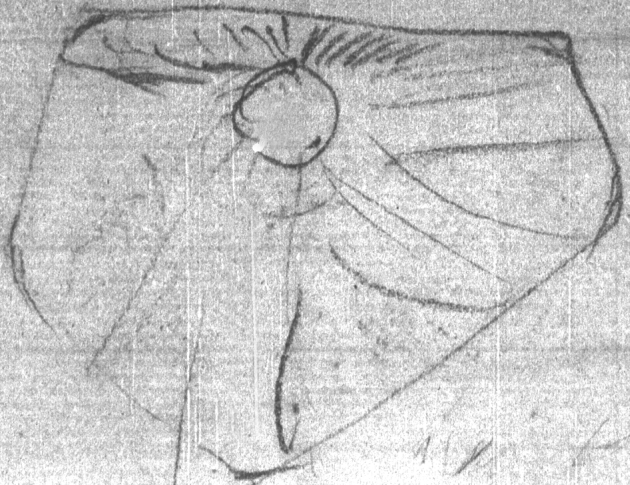 [gr SN or Hu] S 56 E for the more southerly
[gr SN or Hu] S 56 E for the more southerly
6th — Block of granite 3 [straps] 2 feet = 11 feet
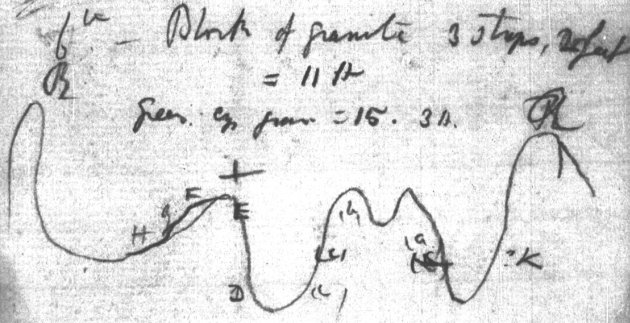 [green cy grain] = 15.3 ft R H G F E D (C) (C) (b) (a) (c) ?K a
[green cy grain] = 15.3 ft R H G F E D (C) (C) (b) (a) (c) ?K a
[page 23]
M. O'Hill: is under 1000 ft.?
(a) 68 W ∠
25.
(b) 70 W ∠ 22 3.8
| (a) |
68 W |
∠ 25 |
|
| (b) |
70 W |
∠ 22 |
3.8 |
| (c) |
55 |
∠ 30 |
irregular |
| do |
60 |
∠ 38 |
|
(+ High peak S 46 E great [smi] H S 54 E)
(D) no stra
t
(E) dip N ∠ 5 (?)
W F 81 — 11 north D do 69 — 15 G 75 — 17 do H 70 — 11
(C) 70 25
K 80-18
[page 24]
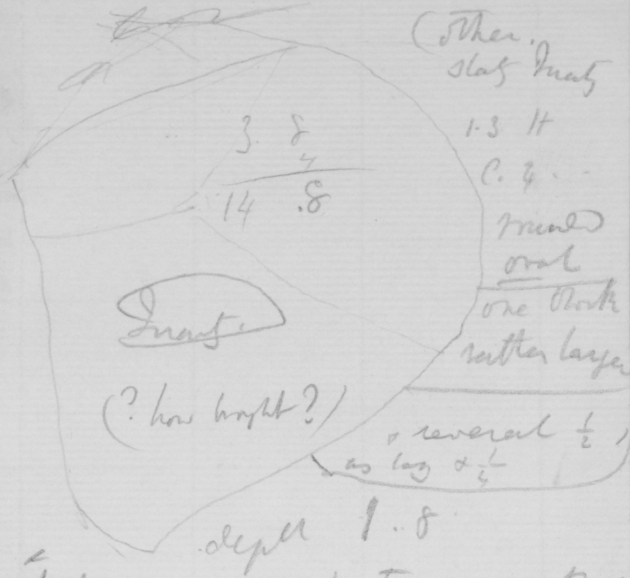
circum 4[.1]
(other slaty marl 1.3 ft C.4
rounded oval.
(one block rather large)
& several ½ as long & ¼
depth 1.8
Quartz
3.8
4
14.8
(? how brought?)
higher parts most stony: one Rock I should think 4 ft diameter —
curved mica slate —
pebbles generally few & small size apples to head. — angular — round some rounded, some angular. —
[page 25]
white with curved dark lines of small gravel. —
white more sandy & exactly like C Virgins. —
Was the oyster bed removed, or [prevented] depositing: bed of alluvium continuing from animals & subsequently broken shells higher part 200 feet high? —
double elevation again convenient.
great boulders left in Shoal Harbor. —
[page 26]
P Rocky 26 N. Sarmin
+ 46 Peak E of S Scarcely ¼ of mile from end of Point Rocky — middle [of &] snowy range 55 north side P R. 70. 45 Feb 25th [1834] 2d Station A & B with common green rock — (B is globular concretions
[page 27]
Base S 30 E ∠ 18º — great divisions: there were here several others at various [inclinat] angles & quartz pebbles 1853 (D). Conchoidal basalt Garnets 1854 Trachyte 1855 Variegated (vein like mass) green all together near [very] [summit] Porphyry Ridge N 70 E = E 3º S & W 3º N
Vertical smooth planes generally common to tops N 50 W = N 29 W & S 27 E first impure sort Summit Porphyry & (D) (1853) Quartz veins. Cleavage S 50 E & low ridge
[page 28]
( W [Lakes] most uneven: rugged — The breccia like rock generally
lowest. — little action of water over ledges uneven hill
At very summit an apparent South little Dip. —
Doubtful Breccia, some of the pieces were an inch large; — Read
Wollaston Island. —
I do not think there is any slate & C. [Decert] not Slate.
P 90
[page 29]
Feb: 27th [1834] Slate dip 48º to exact South (true)
N: end of Navarin Isd
Cliff of Detritus — angular rounded stone. [no] lines of deposition —
small & few stones — earth color
W (Compass) 72 S D.—
W & E 59 S D
Porphyry pebbles between Falkland Islands: & Staten Island.
[page 30]
[Uni] to [Front] Slate run W ½ N sandstone dip W by S?
No dung beetles Falkland Islands
Why knowing that Patagonia has been elevated in some 1500 feet
horizontally above sea (& probably 300 feet below) why not Tierra
del Fuego? — Cleavage & stratification entirely distinct — F. Islands.
[S.] Usbourne pebbles outside coast.
What animals Toco Tosco. Aperia.
Rabbit Dung
Black Rabbit.
Read Falkland Geology
[page 31]
Birds (: Penguin)
3 Pounds. Rabbit. Magellanicus1 ask Gregory Indians about do
Henslow importance of preserving labels

Jackass Penguin demersa:2 perpetually rolls head side to side; as if helook out at anterior angle of eye: — noise exactly like Jackass at sea one deep note: — crazy, very quick, help of wings head stretched out— very brave diver — quickly moving wings very rapidly: fishing out at sea — cunning —
1 Specimen 1885 in Zoology notes, p. 209. Waterhouse listed Lepus magellanicus as a black variety of the domesticated species of rabbit in Mammalia, p. 92.
2 See Journal of researches, pp. 256-7.
[page 32]
The elevation of vertical cleavage in its exact direction would only be showing by a dip outward inward on both sides: Von Buch.1 — M
Habits & geographical limits of brown vulture: Rats & mice & foxes on small islands & Georgia Black rabbits breed. — are not found excepting where there are grey ones: there are white ones &c &c Henslow cross means Rabbit : Insects Calcareous concretions in India —
1 Possibly von Buch 1813.
[page 33]
Sunday — 16 [March 1834]
Hills W ½ N run —
Slate & sandstone latter both with cleavage
dipping N ½ W E 50-60
Hills of gneiss dip to within point of N —
= Flat topped very long oblong & upheaval S. 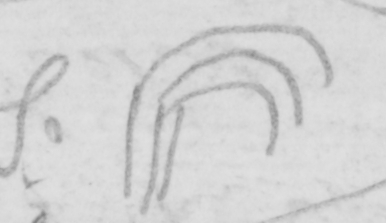 [curved strata]
[curved strata]
great curved plates
(2) vertical plates
(1) small oblong
Slate (lower parts of country)
E & W run
[page 34]
The double Quartz range runs W by S & WSW
The Quartz is granular & very often contains mica specks no white [parallel], but little ferruginous the N. dip, the flat topped
(castellated) & 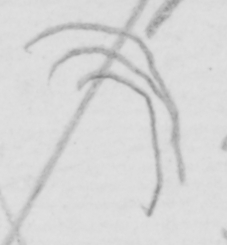 [curved strata] & the Southern curvature from anticlinal line: — in a [piece] 4 or 5 feet long & above 3 thick curvature 1/8 of [circle] — plain of divisions forming smooth domes: original however there is much
[curved strata] & the Southern curvature from anticlinal line: — in a [piece] 4 or 5 feet long & above 3 thick curvature 1/8 of [circle] — plain of divisions forming smooth domes: original however there is much
[page 35]
fracture: — The 2d Point of upheaval was at Southern base of great
range — & directly afterwards we had the vertical plates: —
Hail & wind, geese — Cattle country: — Sleep warm M
Monday [17 March 1834]
R. del Toro — Bone burn.1 geld Bull — snow & Hail. — [Snipes] geese Hawks nest &c cry Sandstones sometimes
1 'the Gauchos soon found what to my surprise made nearly as hot a fire as coals, it was the bones of a bullock, lately killed but all the flesh picked off by the Vultures. They told me that in winter time they have often killed an animal, cleaned the flesh from the bones with their knives, & then with these very bones roasted the meat for their dinner. What curious resources will necessity put men to discover!' Beagle diary, p. 230.
[page 36]
generally more or less slaty running NW by W again appearing horizontal very many valleys, parallel to range & int like furrows in the sea —
Horses very expensive 100 ps each. — out of 29 — 10 arrived safe & 4 now alive & Bulls & cold. — no wild horses here. — only cattle. —
Sierralarga— between [Pysandria] & [Inssiona] crosses the Cochilla Grande. —
[page 37]
Where there are black rabbits there are others
Yellow legged hawks — females
Foxes have holes, generally silent excepting when in pairs
Hawks remain here whole year most in winter
Tuesday [18 March 1834]
Slate running NW by W Dip N Granular quartz range dip WSW ½ S 40º ! point of Sierra & one point more S
SE. by W. (SW. by W.)
 [strata] 20 yards
[strata] 20 yards
[page 38]
These quartz Hills run NW by W or ½ P more W. & from extreme point of Island [At] sleeping Place coarse slate D SSW
Wednesday 19th [March 1834]
returned home
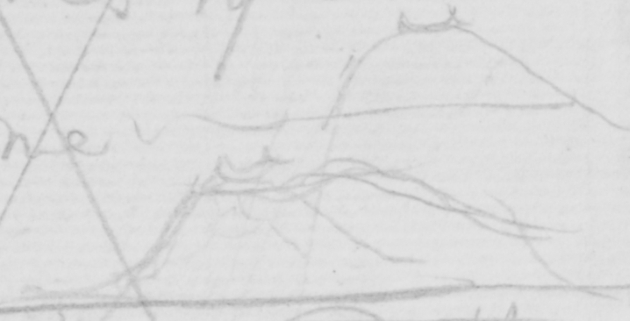
[sketch of hills]
Reread this after this
Carrancha kill Partridge let go again1
horses back — Chimango
(Caracara)2
1 See Zoology notes, p. 212; listed as Polyborus brasiliensis in Birds, pp. 9-12.
2 Large carrion-feeding hawk of the genus Polyborus, but some other falcons may be called caracara.
[page 39]
Tortuous cleavage connected with change in mineralogical change or mechanical. — Barnacles in Tierra del F. from 20 to 50 fathoms Degradation of rocks by snow ??
Sunday) [23? March 1834] DS ∠ 38º (true) (most general) SSW — ∠ 45º pure crystalline granular quartz Rock These subbordinate crests ran W & E Valley of blocks ¼ of mile broad inclination 10º — from that to plain nothing like lava. on crests detached blocks great earthquakes: Georgia (&c)
[page 40]
Flat plain or [Bog] before last elevation. — When there were two islands: — a current eating out present arms: — [Sandra] Orkney Shetland Georgia Desolation are all volcanic line of Elevation line of greatest height runs perhaps WNW (½ N?) (contained a shell)
Intermediate rock, overlies & alternates with [stratif] slate, itself becoming coarse — alternations or passages: passes into sandstone, suddenly assumes cleavage V Spec.n W by W by S — very perfect. or imperfect in proper form
Slate containing much sandstone mingled with
[page 41]
the inclined laminae, & almost alternating, then suddenly the sandstone formed an inclined bed the extremities of which might be seen mingling with the laminae
Monday [31 March 1834] SSW 40º Quartz Crest same range as above
Quartz [Aten] R. [Quartz]. Alla R. — [Porphyry]-slate
(Q A.R). suddenly slate Southern limit of [Lievres] between Port Desire & St Julian
[page 42]
A 8º 45' : 30.083
AT. 55.5. D 55.5
11:45 29.04
A 55 D 55—
5. 50 30.07
A 54. D 54
3.6 |55 = 12.7
= 12.7
55.5 = 13.
3.083
994
30.079
30.079
0.83
0.7
3 | 0.13
.004
30.083 1013
30.087 7.004.
008
004
.079
[page 43]

[base of an arched fragment of quartz]
1702 13.12.7
786 3.9
916 13
50 117
966 39
5617
[page 44]
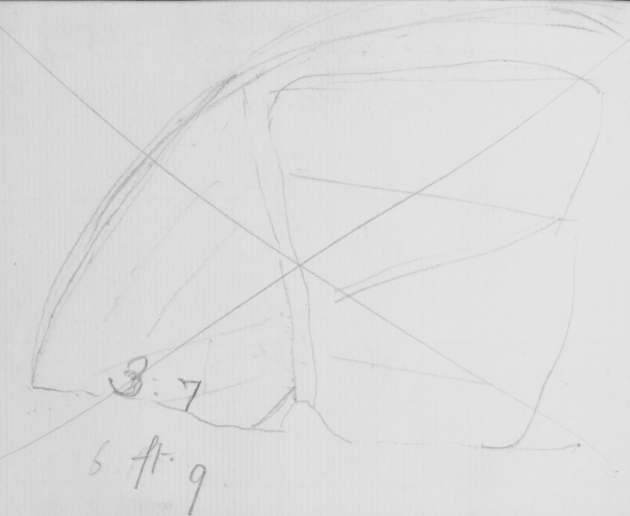
[base of an arched fragment of quartz] 3.7 6 ft 9
[page 45]
& [traverse] also ½ not a part
longitudinal veins with quartz on dome
Behind these broard crest dipping to SSW NNE or S by W N E — 50º
— — 55º —
Crest running W by S.
Main chain do. — [height] hills — N of main valley commence
rather Northerly of this little range. —
[page 46]
on very top. inverted arch: as [running] of arches & [works] from castle so these streams
9.4 120 s 14
3.8
42.12
9.4
51.4
[page 47]
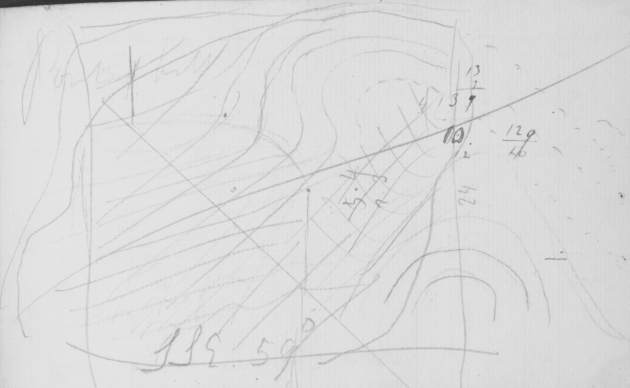
[hillock of quartz with summit of axis-plane thrown over to the south] Part of Hill SSE 59º
13
3
4 |39
10
12
129
40
5.4
7.7
24
[page 48]
Round Hill. +
next E Hill [fort of on hill]
S ½ W ∠ 70º
+ N by W ∠ 47º Has Lowe1 ever seen these big oysters of Patagonia? Earthquakes. — F. Islas Gauchos
1 Captain Lowe, a sealer. See Beagle diary, p. 148.
[page 49]

[cross section of the domed structure of South Berkeley Sound]
[page 50]
Sunday ridge of greatest height W & E. — of wave WNW & ENE — Walking up a dome step by step from excisement: at foot due north a slight Southerly dip. evidently part of regular southerly crest, but more horizontal — points of upheaval not exactly in straight line in range like swell

[curved hills] ESE little dip WNW
[page 51]
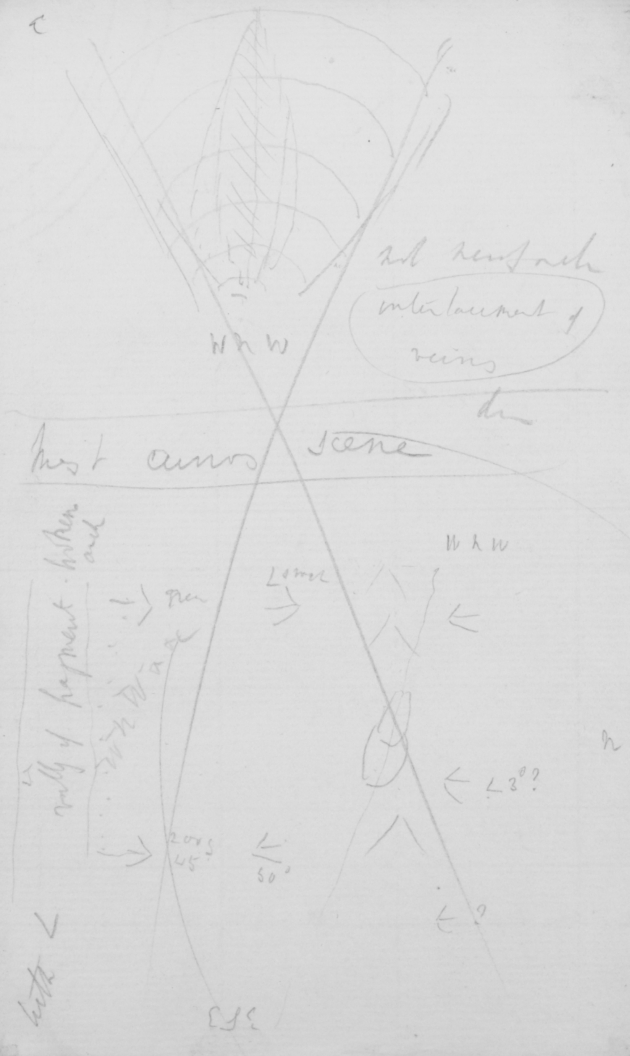
[diagram of zone of upheaval south of Berkeley Sound] [a] WNW not [nearly] [such] interlacement of veins [due]
most curious scene S
valley of fragment — broken arch
WNW & & c [green] ∠ [small]
200 by 45 50º ESE WNW ∠ 3º ? N
[page 52]
great hill long nearly as high as certain chain wave, more regularly anticlinal: in parts like crater. Wonderful scene of violence. Vegetation modern: — fragment as big as Churches: — valleys on each side a mile wide fragments: — line of view rather different from that of range in the line front hills —
3 ranges between Berkely Sound & Sea. — W & E W by S the other end —
[page 53]
Hills North of B. sound several [orients] (W & E (?)) centre of island more confusion —
Thrush in flocks
Experimentize with pods of Kelp. Nitre rapidly drying: —
Small Hawk iris "honey yellow" — legs — bright yellow . skin above blue beak do: male feeding on Carrion! — (1926)1
Blue leg Vulture. Male.
Super-abundance of inarticulate Corallines: Kelp Corallines
1 Specimen not in spirits 1926 in Zoology notes, p. 399, 'Ornithological notes', p. 233; listed as Milvago leucurus in Birds, pp. 15-18.
[page 54]
Depth at which Kelp grows Limits on both sides of coast — all Southern Islands? —
Kelp South Islands — Tristan da Acunha Sorrell?1
Exception of Kelp Fish in Falkland Islands2
Re-dissect Obelia3
Mr Stokes says kelp little to N of St Elena (about Lat 43º).
10 & 15 Fathoms Kelp grows generally
Degradation of land by snow
Southern limit of Agouti.4
1 Possibly a reference to Thomas Sorrell the boatswain of the Beagle.
2 See Beagle plants, p. 211.
3 Specimens 597 and 1161 in Zoology notes, p. 147.
4 A rodent of the genus Dasyprocta, related to guinea pigs.
[page 55]
Specimen of Kelp:
Pods of Kelp Experiment[ize about] the Nitre. —
Barnacles very common. 30 to 50 Fathoms. Coast of Patagonia. Has
Lowe seen big oysters? C. [Mammoth] Gregory B. — Birds. Petrels:
Puffins. where build?
Governor Andes [illeg] 11 14.89
Hares Viscachas at Coquimbo Molina Pitui Silvago white tuff T del Muscicapa1 Red back shore finch builds in bushes No snakes
1 Compare with Zoology notes, p. 249; possibly the same species listed as Xolmis pyrope in Birds p. 55.
[page 56]
24th. — [November 1834]
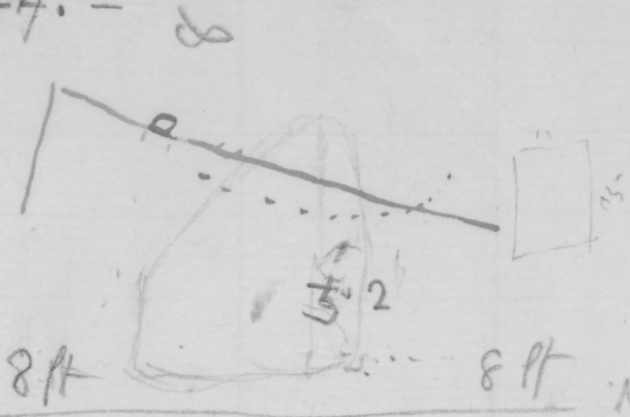 ∞ 8 5 2 15 8 ft 8 ft
∞ 8 5 2 15 8 ft 8 ft
Nov. 1834
Started, took horse in Chacao, followed the coast, winding in after every Bay: saw many civilised, pleasant to see in any case natives. small copper coloured men — not very like Fuegians: Scenery exceedingly picturesque, beautiful cleared spots & pretty enclosure. magnificent forest path like road to Castro fine view of Straits of Chacao: Volcano beautiful many crosses, dangerous straits
[page 57]
Cone of snow. — plains of different altitude. thickly wooded: higher ones soft earthy, sandstone with lines of pebbles, granite & greenstone & some few porphyries: lower plain chiefly granite pebbles: all showing curved lines of currents: perhaps different elevations: immense removal shown by reefs from points:
Granite increased as we approached Chacao: one nearly square, singularly little rounded, not more than fragment from mountain at base (very hard used for mills)
11. 1418. & 9 ft high: — every where signs of upheaval: one place apparently at [80] height of 200
[page 58]
200 ft — difficult to ascertain from people eating so much Marisco:1
Said to occur in interior: Cordillera said to consist of several rows. —
?pebbles different? — LecuyAre these plains contemp: with ؟
Cheucau.2 making an odd noise people will not start Governor old Spanish Colonel — Son without stocking — miserably poor indifferently asked whether flag would always fly: — — Cordilleras much more distinct peaks: the 2 or 3 first rows, coarse & fine Syenite & Granite (Douglas3 — Volcan — very regular cone
1 Spanish name for sea food.
2 A bird known as a Chucao Tapaculo (Scelorchilus rubecula). See Journal of researches pp. 351-2.
3 Charles Douglas, surveyor and pilot, long resident in Chiloe.
[page 59]
Corcobado — Trachytic — (St Jago do?) — Some Many of the
blocks ½ or ⅔ of the above size: —
25th [November 1834] Torrents of rain & in night Hurrah Chiloè country plain from 100 to 200 ft thickets & low woods here & there patches of cultivated ground — Huapilenous, same general formation. many fragments chiefly granite. — some as ½ large as yesterday & angular: foul wind drove us in —
"Huapi" means Islands: yet now nearly all peninsulas. proof of rise.
— Big drops of rain
[page 60]
Expect a Ship at P. Castro Reason ?? =
(26.th) [November 1834] With a too strong SE breeze & a splendidly clear day made sail & reached Puerto Obscuro only good Harbor. — country same: Saw Indian party: one man exactly like — York Minster; others rather handsome. more color like Pampas — Manners pleasant dress &c &c like Spaniard — very poor. Cacique yet remaining but have little power since tributa disb. abolished — when any officer, as land surveyor come down, they accompany him with badge of office a silver cane: they talked their
[page 61]
Indian language & very little Spanish. = The Cordilleras very magnificent certainly much less lofty than in Chili more regular than yesterday. Osorno immitting much smoke snow considerably melted, always in state of activity. — Saddle-backed, gentle cone, with immense crater emitting very little smoke — said to possess much sulphur till [some] years since, was hardly known as Volcano. when great eruption made a plain concave — Corcobado — 1 to 3 eruptions annually — Inhab: of Castro expect earthquake, when no eruption during 1 to 3 years
[page 62]
Some other mountains looked as if extinct Volcano. — Geolog. Formation same, any proof that lava has not proceeded from Andes i.e a central crater — — few ∠r blocks of granite —
Presence of Indians owing to their being a large tribe being encouraged & land given them at time when Osorno was betrayed but these tribes remained constant. —
Puerto Obscuro beautiful little cove. several houses almost all grandchildren
[page 63]
badly off for ground, but too idle to clear more only breed — Have to pay Government & surveyor, mentions price: & 3 auctioning settles it — Chili government making retribution to Indians for their Tributa. Cacique 12 quadras wife half — Militia-man. — to wife ½: aged 4 quadras: during tributa Indians cleared land & were then driven away.
27th [November 1834] — Again fine day. strong foul wind — arrived at the cove of [Tuicari]. San Corcobado like same name at Rio. Trachytic
[page 64]
Blocks of granite. Saw at same time 3 volcanos & some most beautiful & regular snow cones far to the South: deception of semicircular arrangement: Table land from 2 to 300 ft high. — woods for fire Tropical from great intermixture & diff colored stems —
Formation of the Chaciques apparently the same as before —
Elmis beneath stones.1 —
Small chimango eat Potatoe when planted & bread. —
Rapid tides amongst the
1 Specimen 2338 in Darwin's insects, p. 83.
[page 65]
Islands — // Small Crustacea1 purple clouds of infinite numbers. pursued by flocks of P. Famine Petrel //
Natives eat much Marisco & Potatoes, — all Indians in the Chaciques & some other Islands. —
28th [November 1834] Chimango torments. swing swang the
Carrancha2 —
In the census of 1832, 42 thousand inhab: of all sorts in Chiloe islands. = granitic blocks rounder. & far fewer? —
Landed at P. Tenuan, fine grained clayed sandstone. with remarkably even laminae, the very
1 Listed as specimen 1104 in Chancellor et al. 1988, p. 217. See Journal of researches, p. 355.
2 See specimens 1932-1933 in 'Ornithological notes', pp. 233-4.
[page 66]
same as at C. Virgins. greasy with water at sleeping place Quinchao (splendid day & clear weather) same substance with singularly convoluted thin layers in domes running NNE & SSW? All the Islands certainly once a plain from 200 to 300 ft. — Appears to dip to East. ∴ more interior higher land. — Channels in some places deep.
— Met many ½ blood Indian families — when picking up Marisco singularly like Fuegians
[page 67]
Something like St Julian Porph pebbles: || but coarser texture not Porphyritic + ||
29th — [November 1834] "[Tey]" Granitic blocks certainly rather rounder — country in all parts more inhabited many periaguas.1 — Douglass sold 8 ½ square miles near Carlos for about 350 dollars. given by for Spanish bills. — nobody has an income here. — in a long life time industrious most rich person may gain 4 to 5000 dollars which is hoarded up. every family having his stow-holes. : Gomez, & wife noblemen of Spain came out
1 Spanish name for small boats.
[page 68]
to Lemuy by constant intermarriage with Indians present linear descendants can hardly be distinguished from Indians — whilst on other hand the present governor of Quinchao is very particular to keep his blood pure. Name of saddle-shaped volcano — [Serro] de Vilcan ?? = Language of Chauwes [Chahues]
T. del Fuego Petrel: in a flock by hundreds & thousands flying in strength irregular number lines; occasonally uttering odd cry
[page 69]
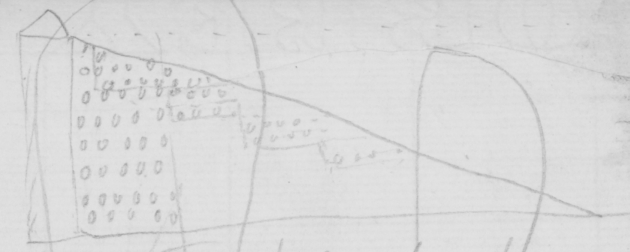
Explanation of gravel, during rise constant enormous accumulation: contrary facts the transportation of ∠r boulders — & Julian pebbles —
Castro granitic greenstone & many Basaltic ones: Coarser horizontal strata of soft sandstone: land about 400 ft high: Reylan Point. —
Formerly Pueres1 were brought in great abundance from Cabluco constant gathering have reduced in
1 A sea squirt (Ascidian), specimen in spirits 1165 in Zoology notes, p. 357.
[page 70]
numbers but since 1825 they have become abundant at Chacao were they formerly did not exist: The Nautilus is thrown up periodically in great numbers at Juan Fernandez & coast of Chili. =
Layer of hard rock, composed of crystalline rock Volcanic crystals overlying horizontal slaty sandy clay — bed inclined, current inclination. — generally this degrades down into an earthy sandstone with black specks; the common formation
[page 71]
seems as before —
Signs of steps in these forms [sketch of terraces?]
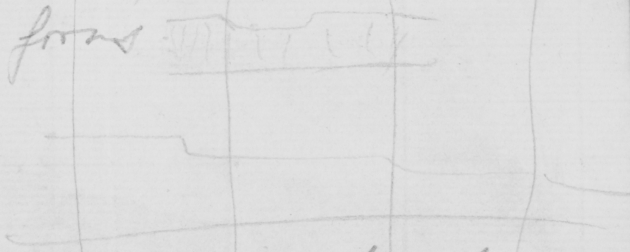
but very much alluvial action as probable
30.th [November 1834] —
Bybenes or Huyhuyenes Indians formerly inhabited Chiloe, some few Baptized probably driven away by consumption of Mariscoes: believed to have gone to city of Casares, perhaps those Indians seen by Bynoe1 were [this] tribe
1 Benjamin Bynoe (1804-65), Assistant and then Acting Surgeon on the Beagle, 1832-7.
[page 72]
1100 Indian surnames, descended from as all speak the same root Beliche language. — spring from some brought en commendo from the north supposed near Osorno & from Chauwes Chahues & Ragunos, [who] remained at the taking of Osorno not more than one or two families of the Bybenes now remain in the Archipelago speak quite distinct language.
Douglas knows a family of Bybenes near S. Carlos. perhaps Chawes & Ragunos: Molina
Out of these 1100 some of the Indians are totally pure
[page 73]
Spanish blood, others such as Gomez nearly pure Indian do not come in the list: yet perhaps a good approximate number —
En Commendo Douglass believes to be each Spanish family had a certain number of Indians to instruct in Christianity & obliged the Indians to work for so much time. — All these Indians descended from but few Indians: A Cacique of the Ragunos, who had been placed after the taking of Osorno in the Islands of Calbuco, came with 12 periaguas to assist the Spaniards against the other Indians who had risen against them.
[page 74]
Indians have few superstitions yet left hold converse with the devil in a cave: formerly sent, for this to Inquisition at Lima. The Bybenes now only inhabit Caylen. —
Arrived at Castro: never before saw a truly deserted city: roads thick pasture: a pleasing cultivated country fringing on the coast the dusky green woods. Jesuits church highly picturesque fine dome all built of plank: very poor people retired solitary spot. eating what they produce & hearing little of the
[page 75]
rest of the World. — (Chacao inhabitants driven away. in old Spanish time by burning their church)
[fast] numbers of chapels in all parts of country. Rode about in the neighbourhead to see geology: all the lowest beds consists of Talcaceous (V. Spec) mica slate, with thick curved layers of quartz which sometimes is nearly pure laminae: upon this I saw great bed of conglomerate, & near same locality the slaty clay — sandstone (heard certainly
[page 76]
of Granite in the interior). In another locality, a mass of inclined columns of semi-carious white Trachytic rock (V Spec) columns chiefly of this shape seem certainly to overlie the gneiss though did not actually see contact hence Chiloe & Cordillera of primitive rock from which melted matter has flowed & fringed by a modern bed. = There are inclined very distinct (3 sites at least) most manifest plains, with escarpements. The lowest from 100 to 200 ft. has a fringe about 30 to 40 feet of [comminated] recent. The highest perhaps about 500
[page 77, excised, located in CUL-DAR35.297Ar]
Castro
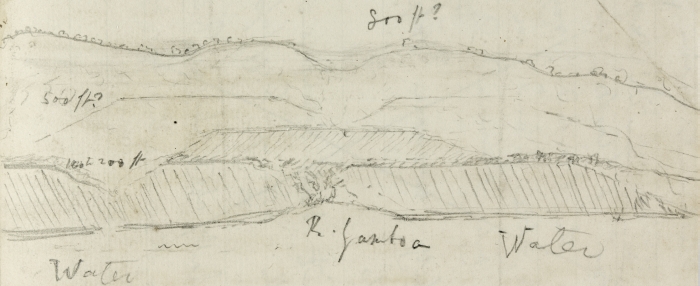
[sketch of terraces at Castro, Chiloe] 500 ft? 800 ft? 160 to 200 ft Water R. Gamboa Water
Perhaps gneiss dipped to NW ؟Sea-shells — extensive formation:
[page 78, excised now located in CUL-DAR35.297Av]
sea-shells. — extensive formation: ؟ Perhaps gneiss dipped to NW small ∠???
The dust of S. Carlos, came from the Corcovado, very thick, whole island, in 1827? & 14 miles to Seaward Douglass: carefully reexamine Valparaiso shells Point nat — Peninsula Lacuy shells high up Douglass a doubt about Chacan Boulders one strong shock & three days & dust band Particulars & date of 1831 of small ones great Earthquake: shortly afterwards in activity Stone off S. Carlos. gradually was nearly laid dry & gradually the water regained: & frightened people [illeg]
[page 79]
Cuy a rabbit in the Bichiche language. V. Falkner
The earthquake of Chiloe had a severe shock of ½ minute & three days small shocks. =
The Valparaiso have forgotten their language Bichichas in Caylen Tapaculo1
December 1st [1834]
Left St Ca Castro early a large group watching us: Indian family with periagua — young man, in morning wet to skin from the torrents, with thin trowsers & drawers professed to be quite
1 A bird of the genus Sclerochilus and the larger turca belong to the Rhinocryptidæ, peculiar to S. America. The word tapaculo, derived from the Spanish, means 'cover your posterior' because of the absurd way the bird carries its tail. See Journal of researches, p. 270.
[page 80]
comfortable: heavy rain during day: proceeded but short distance to Lemuy. so thickly wooded to waters edge (for fish describe coralles) great difficulty in finding sleeping — large populations of ⅔ Indian blood, much surprised at our appearance. talking said the many parrots they had lately seen told them what to expect the "Cheucao" to beware. —
Many cellular Volcanic looking pebble near Castro
[page 81]
Whole cliffs composed of this Castro Creek — soft yellowish sandstone, passing with a finer grained brighter yellow sort of greenish clayey variety: globular concretions of grey hard sandstone — very like Lacuy
North W point of Lemuy composed nearly similarly but none uniformly soft sandstone. V spec: many ferruginous veins; few occasional line of pebbles: in very many parts patches & extensive horizontal layers
[page 82]
of black Lignite, structure of wood yet very visible: is said to communicate much heat in furnace has been worked tried pieces all flattened; some layers several inches thick: probably from high land of Chiloe, previous to its elevation — Summit of cliffs gravel
Many rounded blocks on beach of petrified wood same inexplicable occurrence as before. One fine white
[page 83]
granitic block. pentagonal mean height above gravel [sec] 12 feet — one side however 16 feet — mean circumference at middle. 52 feet — like a house — Granite probably from Cordilleras:
Smaller ones high up
= Fine Beroe1 fine pu up rose—
= purple with splendid [iriscident] ciliæ
= Shells at Lemuy same elevat: as at Castro
Chucao. I know 3 distinct noises2 — nest ??
1 A similar creature was described in Journal of researches 'The structure of the Beroe (a kind of jelly fish) is most extraordinary, with its rows of vibratory ciliæ, and complicated though irregular system of circulation.' p. 189.
2 See Beagle diary, p. 271.
[page 84]
2nd [December 1834]
(A) The common yellow massive soft Sandstone, in which the silicified wood is found
(B) soft silic: wood from great branch in do
(C) The wood coal showing the leaves, a laminated structure is the the whole mass? — Perhaps leaves may be applicable to mar much coal — which has formed ؟commonest, in which it appears just like wood.
[page 85]
A little way above Yal. — I found in the usual sandstone (A). some flat concretionary & grey hard sandstone masses in which were horizontal seams of shells. These could be very imperfectly discovered, but from what I saw seem are certainly not such as now are heaped up on coast — a large common Cytherea.1 taking the places of Concholepas2 of Valparaiso — Before recent we may conclude — It is very strange, in such an extent of cliffs no trace of shells excepting in this one spot
1 A clam, possibly the species named Cytherea sulculosa in South America, p. 25, plate 2 fig. 14.
2 The so-called Chilean abalone, a species of large carnivorous sea snails.
[page 86]
where the rock was harder & rather different from general — Is not the presence or absence of shells owing to chemical nature of matrix? — Mem: observ in E T. del Fuego: — at the point of
The above Sandstone beds were capped as at Lemuy with thick bed of cemented gravel. —
At the point of Yal. Harbor the laminated sandstone. — passing in parts into a conglomerate alluvium like those to the north (round pebbles of all sizes) & capped as
[page 87]
before with great gravel bed. — plains 300 to 400 ft high. Theory. where islands exist generally the softer sorts of sandstone abound, which probably are not "recent" beds. — they are capped with great bed of gravel, is are not the low gravel plains of the north of same nature as these & perhaps deposited & remodelled. as in Patagonia from the gravel of the higher series: near S. Carlos we also see the sandstone beds capped with gravel. — Mem: during depos Volcanoes existed? Pumice?
[page 88]
Where there are creeks this formation exists. =
Made little progress during the day owing to light weather: Continues thickly inhabited. coast more so than almost any place I have seen —
Inhabitants purer & purer Indians: excessively humble & civil, most innocent good natured people (one most true Indian) wanting salt, Tobacco, Indigo & every one of these luxuries — speak little Spanish. —
Forme I mentioned having found at Lemuy on beach very much silicified wood. — one piece penetrated by Teredo.1 likewise
1 A genus of bivalves that bore holes in wood.
[page 89]
I found many fragments on coast above Yal — At last I found in the yellow sandstone (A), a great trunk (structure beautifully clear), throwing off branches: main stem much thicker than my body — & standing out from weathering 2 feet — central parts generally black & vascular & structure not visible — This tree coetaneous (near in position) with the shells of above: it is curious such a sandstone chemical action in sea holding such silex in solution vessel transparent quartz: This observation most important, as proof of general
[page 90]
facts of petrified wood for here the inhabitants firmly believe the process is now going on — Part of the great block was more sandy than siliceous (B):
The great Lucanius1 makes when approached or molested a loud noise, which almost frighten a person = Inhabits. T. Firma.
Carabus:2 logs dark forest: most powerful disagreeable smell & acrid juice
Bluish T. del F. P. Famine Tyrannus3 egg course large nest
1 A stag beetle. See specimens 2110-2111 in Darwin's insects, p. 81. Also discussed in Descent chapter 10.
2 Specimen 2327 in Darwin's insects, p. 83.
3 Specimen 2081 in 'Ornithological notes', p. 249; listed as Xolmis pyrope in Birds, p. 55.
[page 91]
3rd [December 1834] shade green
 [a frog] Under side1
[a frog] Under side1
Throat & breast & [cheeks] rich chestnut brown with snow white marks thighs blackish with do. legs yellowish with do
Upper side
Pale rust color with posterior part of body, & thighs & anterior marks bright green: iris rust color pupil jet black. jumps dark forest point on nose.
other above blackish brown with narrow bright yellow medial line
1 A frog, specimen 1086 in Zoology notes, p. 256; listed as Rhinoderma darwinii in Reptiles, p. 48, plate 20. fig. 1, 2. Now known as 'Darwin's frog'.
[page 92]
only proceeded to P. Detif owing to Calm: view of Corcobado (saddle-shaped Volcano chitan Lildeo near Estero de Reloncavi & 2 other snowy cones. over the inland sea, like glass, only rippled here & there by a Porpoise or logger-headed duck seen from a cliff, through an avenue of various lofty evergreen trees, with fine white flowers & sweet smell, how mistaken in climate of Chiloe! The point is composed of
[page 93]
beautifully horizontally laminated clay-sandstone (specimen D), variation in color for every ¼ to ½ inch (beautiful basements to buildings & columns) the junction of the [shapely] variations in color like carpentry; probably particle arranged after deposition capped to certain degree with aggregate gravel. Part 200 to 300 ft high.
Said to be Volcano far south of Corcobado.
[page 94]
4th [December 1834]
Isd Sebastian, contains much very fine clay-stone, pale color.
adhesion to tongue hard. — Douglass
؟also Volcanic?
P. Famine Petrel very irregular in its migration suddenly appearing & disap. in countless numbers in certain parts of the Islands
Both night & day very squally (. Mem at Lemuy Douglas telling Sillador that by mistake we should certainly shoot anyone who walked about at night perfect humble acquiescence)
[page 95]
arrived at night beautiful harbor of Quelen: N B. where basins with narrow mouth geologically striking in number & must in upraised land give a curious lacustrine appearance. — Cause of this depression in bottom? —
Inhabitants certainly much less frequent, the whole line of Tanqui, without one cleared spot. —
At P. de S. [Aytui] cliffs from 100 to 200 ft composed of alternation of nearly loose gravel of different sizes & sand
[page 96]
The country bordering the coast. — Any all Tanqui would seem all to belong to one plain of low altitude upon which the higher series rests; extending to islands of Alao & Apiao but not reaching far to the South. —
5th [December 1834] —
Sea-snail.1 body when partly crawling oval — post extrem. truncate & scooped out, with large Branch aperture always open: [rt] convex: when quite contracted a cone: above blueish black, with
1 Listed as Peronia, specimen 1092 in Zoology notes, p. 255, identified by Keynes as the slug-like pulmonate Onchidella marginata.
[page 97]
pale white, projecting points & pale halo — edge with alternate spaces of narrow white & blue, the latter color being fimbriated. beneath white, excepting mouth: tentac short terminal black eye: beneath which a bifurcate membrane: high up on rocks, near top of high water crawling on confervae nearly dry: — Onchidium?1 —
Two small Turbos same locality.
Pushed on to P. Chagua, same squally weather in several places on road, mass of alluvium hardened earth containing round &
1 An intertidal slug.
[page 98]
angular pebbles of granitic or Volcanic? (cellular) rocks (perhaps lower beds fine grained) ?? Ch Plains rather higher than before stated it is chiefly East end of Tanqui which is low. —
Very little cultivation: (a man travelled on foot round all the creeks from near Castro to Guildad 3 days & ½ foot journey, to receive value of an axe & a few fish)
[page 99]
6th. [December 1834] —
Doris1 above pale yoke of egg colour foot & mouth darkest colour mantle rough with rounded paps of two sizes. oblong. far surpassing foot on all sides — Anterior tentacula protruding through mantle. anteriorly pectinated with laminae:
orifice on [rt] side — Branchiae 8 Acanthus [head] expansious Large same colour with mantle — dimensions when partly crawling
 [a sea slug] common mantle surpassing inferior Tentac
[a sea slug] common mantle surpassing inferior Tentac
Onchidium bilabiate projecting [hard over mouth]
1 Specimen 1091 in Zoology notes, pp. 255-6, identified by Keynes as a cryptobranch doridacean, probably Anisodoris fontaini.
[page 100]
Eolis1
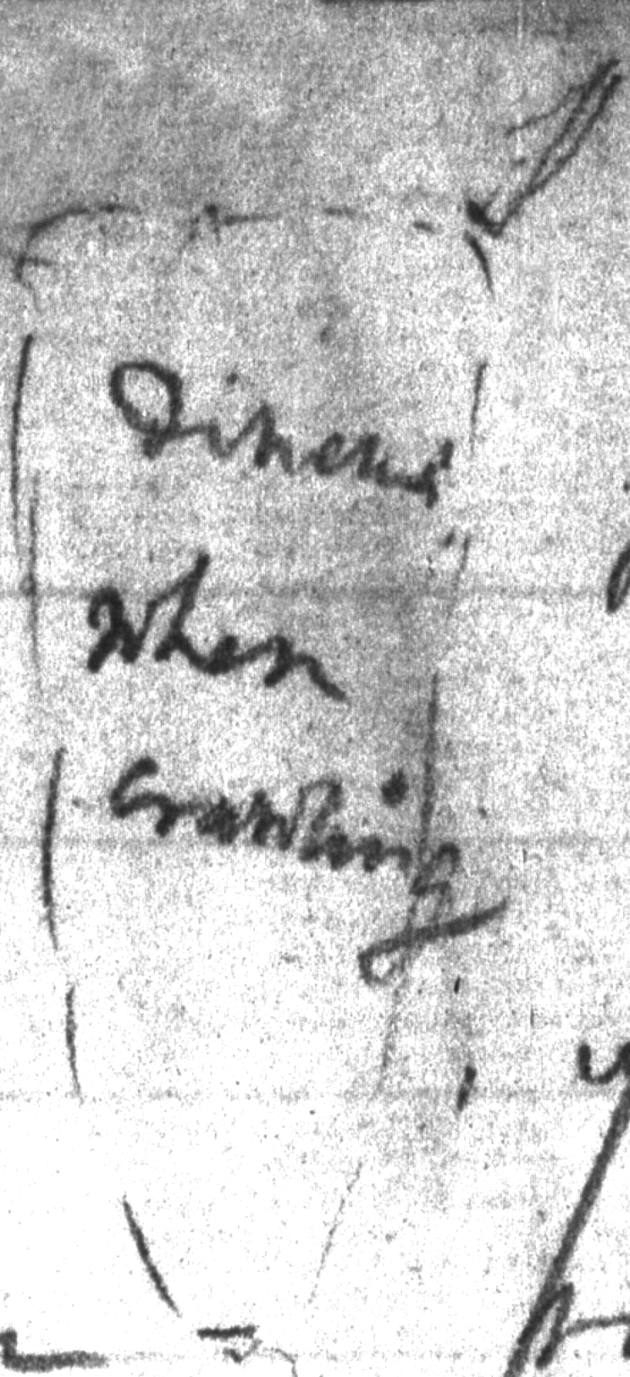 [a sea slug] dimension when crawling
[a sea slug] dimension when crawling
general color "crimson red"? with (lilac with lead colour) under surface & mouth finer — rose color — base of branchiae rather leader color in numerous transverse on each side of clear space of back anterior & inferior Tentacule very long far apart tipped with white, tapering — superior & posterior (arising between branchiae, some way back) blunted & shorter: mantle not surpassing the inferior Tentac: body truncate. anterior. triangular:

1 Listed as Cavolina, specimen 1091 (sic) in Zoology notes, p. 256, identified by Keynes as a aeolidacean nudibranch, Phidiana lottini.
[page 101]
Cheuqui,1 bird like Chucan [shore]
Reached Caylen (el fin de Christianidad), rather better inhabited: day same as before — [In] wooded plains — bought a duck & cock for Tobacco value 3 ½ penny & 3 sheep for four 3 shillings worth of goods. & great bundle of onions 4 handkerchief The news had travelled, of the exact value we attached to the Tobacco (which was in the relation of a shilling to [1] & ½ pennies)
1 Specimen 2436 in Zoology notes, p. 408; listed as Pteroptochus paradoxus in Birds, pp. 73-4.
[page 102]
The cliffs before entering Sts. of Caylen were composed of mud with pebbles (& a boulder) (Alluvium) which passed into consolidated mud (or laminated clay-stone) contained small fragment of common Cytheraea.1 Height 300 to 400 — ft all composed of above sort with very few pebbles the lower plains were composed of gravel which plainly had been deposited after [wearing]
1 A genus of marine bivalve.
[page 103]
the lower beds —
Beaches of present day universally pebbles beach. —
immense number of Granite pebbles
7th [December 1834]
dip WSW ∠ 22º
Mica slate Blackisk [illeg deletion] no small scale country plates (often convoluted of quartz) mica (Feldspar ?). There are many vein like masses of quartz — This first occurred extremity of Id Laytec from which it continued all the way to S. Pedro
[page 104]
many lines of fracture The dip was very constant: easily seen in the mass though not in very distinct laminae & not above ½ a point on either side of WSW. the ∠ was generally small, but in one place 60º — The coast here becomes abrupt. — there are some long saddle-shaped hills — & the coast strictly resembles T. del Fuego — wild nasty day, long
[page 105]
[beat]. open sea: after leaving the Caylen stopped at a hovel, the last house about Lat 43º 10' This is the extreme point of S. American christendom a miserable hovel.— People living on potatoes & mariscos = excessively fond of Tobacco =
Anecdote of gun & powder for feast. =
Features of S. America as regarding Vegetation
[page 106]
killed rare fox with hammer1 — Arrived late in the evening. S. Pedro after absence of fort=night. — Found Beagle arrived yesterday — bad stormy weather failed in surveying outer coast: had visited Huafo & parts Chonos. is necessary to shorten Chiloe ¼ at length! —
San Pedro — leafless trees = enormous
1 Specimen not in spirits 2431 in Zoology notes, p. 408; listed as Canis fulvipes in Mammalia, pp. 12-13, pl. 6. See Journal of researches, p. 341.
[page 107]
trees of Winters Bark & Laurus Sassafras — delightful smell — T. del. Birch — Alerce,1 red Cedar Cones. — walk many feet above ground — like foxes at other times — more moss than in T. del Fuego
1 Spanish for larch.
[page 108]
Isd of Huafo & (Ypun Tertiary) horizontal strata composed of solid — hardish black [grey] (Specimen 2358) earthy sandstone & the yellow sort characteristic of Archipelago of Chiloe
[page 109]
Same formation has silicified & carbonized vegetable substances
Hence near a wooded country as at [illeg]
Strap = 4. 8. ½
[page 110]
([SE]) Perhaps Island bears NW by S ¼ W
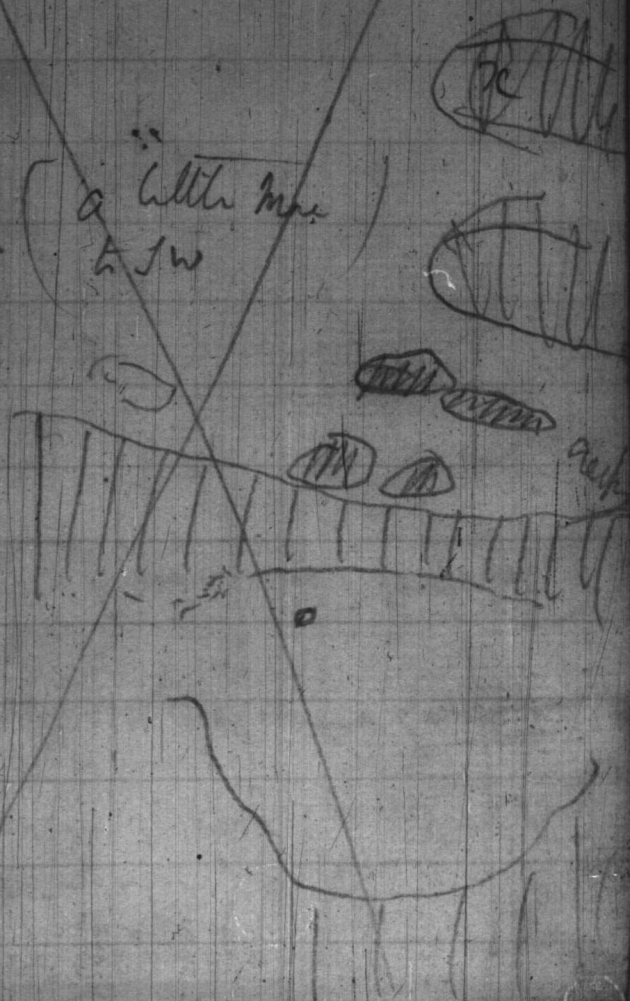
[section of concretions] (a little more to SW) x
[page 111]
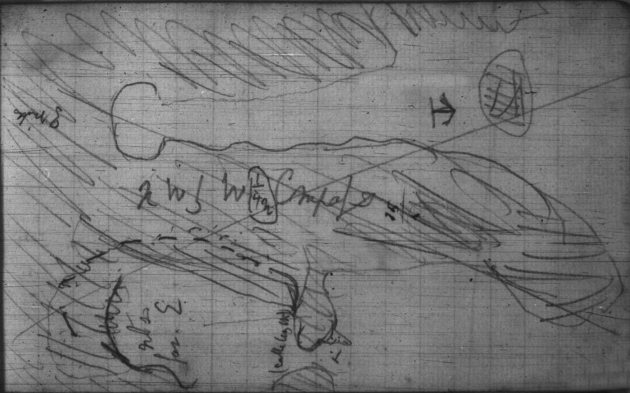
[map of headlands?] 3 miles not so far E (calle length) NW by W ¼ n Compass
[page 112]
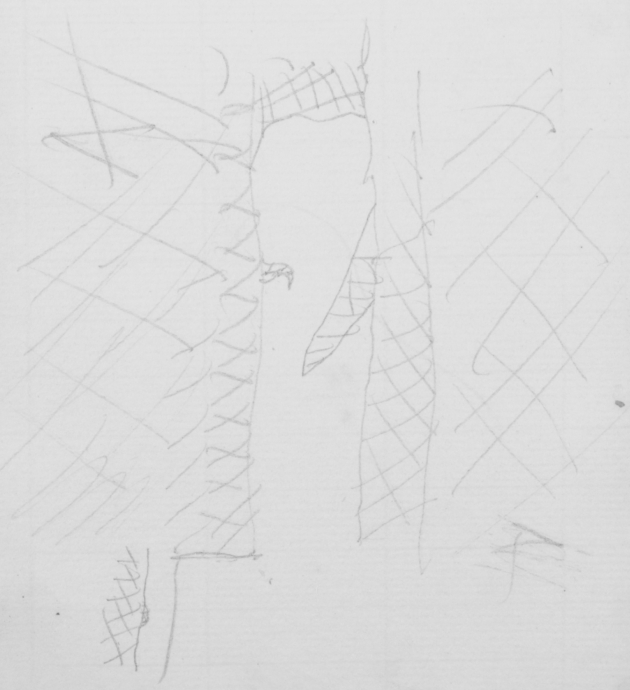
[section of concretions?]
[page 113]

[section of dykes?]
[page 114]
S. Paleña
When did white Porphyry with much Silver in Mr [Budgton] store come from?

6561.8
2296.7
_____
8858.81
656.2
196
____
852 20
____
971 8
4320
47
____
30240
17280
_____
9 | 2030 40
_________
2256
500
____
2756
|
90: 46 ∴ 4320:y
4320
46
____
25920
17280.
_____
9.0 | 198420
_________
2208
5
_____
2708
|
[page 115]
9
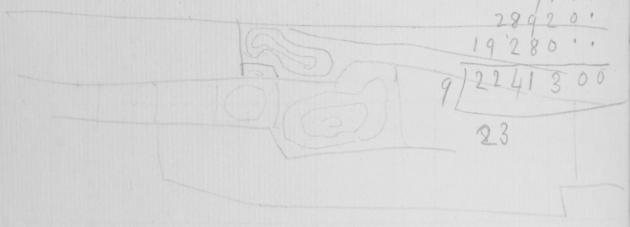
[section of concretions]
4820
46.5
____
24100
28920.
_____
19280 ..
______
9 | 2241300
_________
23
[page 116]
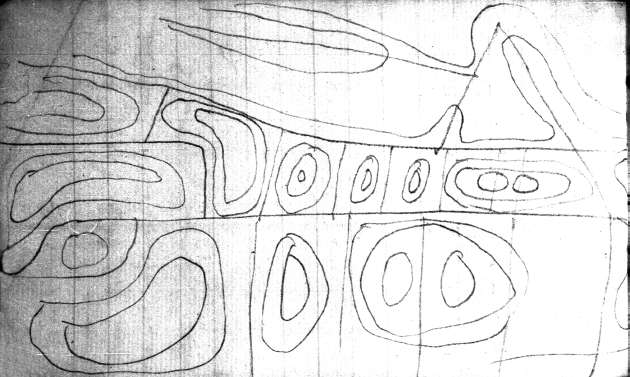
[ground-plan showing the relation between veins and concretionary zones in a mass of tuff]
[page 117]
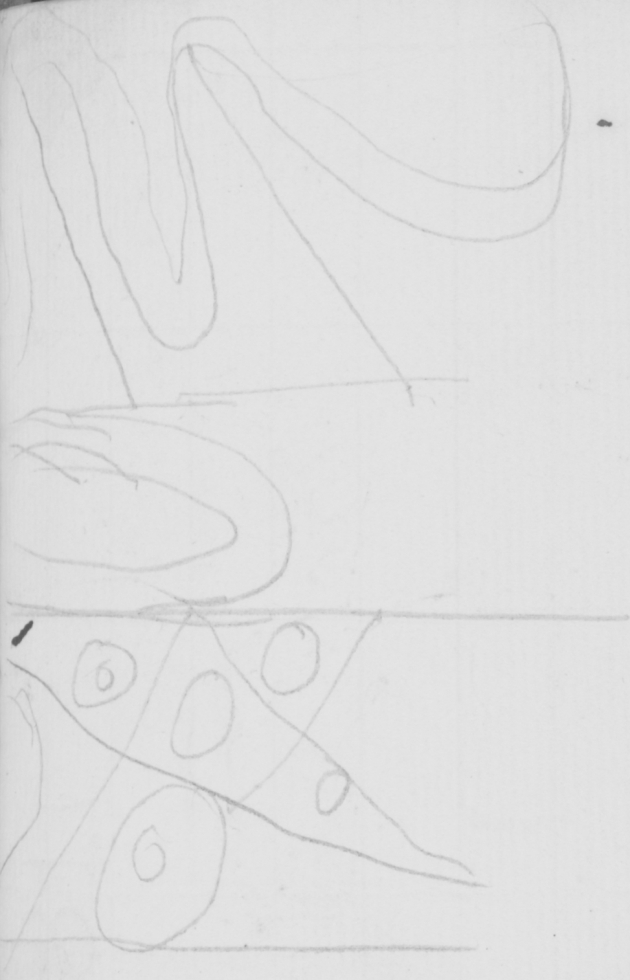
[continuation of previous diagram] 3 or 4 feet Fig. B
[page 118]
Concret hollow — one [layer] 3 — feet sand.
 [a hollow concretion]
[a hollow concretion]
Dip W by N ½ N — 15º
Boulder 4x4 4
Syenite
Wood Agate Angular pebble
2700
26
2700
260
2440
6561.81
1312.41
131.28
8005.30
[page 119]
Eruption of Osorno 20th of Jany
32808.6.9
4
131235.3.6
26246.10.3
157482.1.9
131.2.8
26.2.9
57.5.7
1575
13123.5.1
2624.8.2
15748.1.3
157 68
1/12 5/12 68
7/10+
12/1.00/0.08
[page 120]
pebbles passage in [Cheverea's] Creek —
East by dip —
West dip line of [Huapilenous] shoal — horizontal
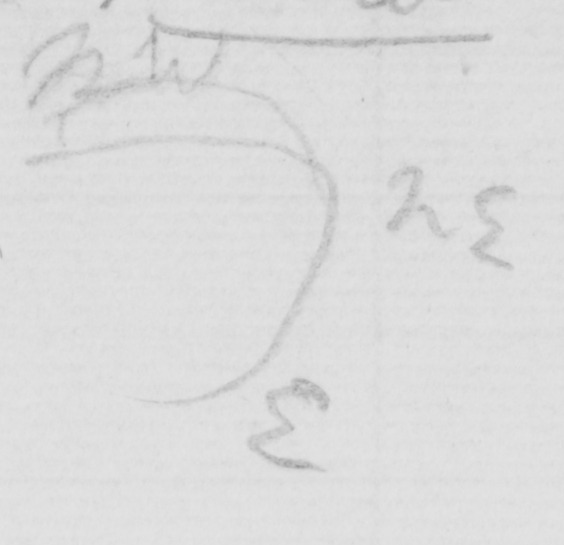 NW NE E
NW NE E
Extension East dip

[page 121]
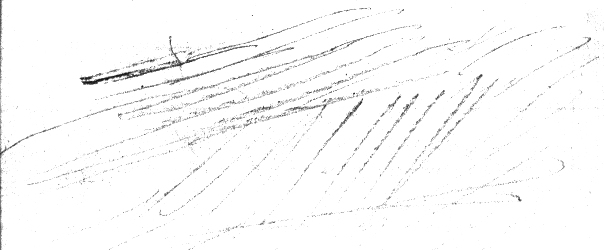 [diagram of strata?]
[diagram of strata?]
The grand line runs (N 6º W) — valley of elevation separates the two escarpements
3 or 400 yards wide —
3 or 400 different regular variation in strata: —
= (dip in one place 25º — generally less in cliff 10º or 12º
[page 122]
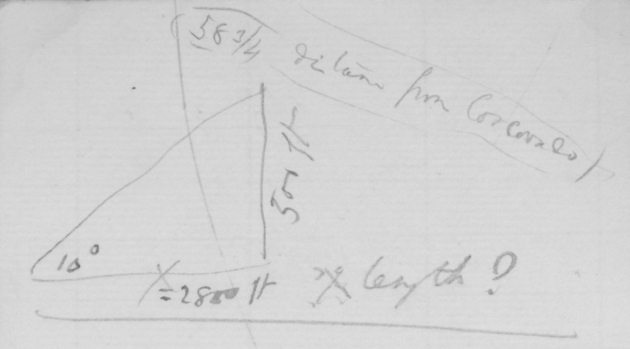
[triangulation of height of Corcovado] 58 ¾ distance from Corcovado 10º
300 ft =2800 ft X length?
Mem concretions bordering line of fissures: yellow Carb of Lime, in veins: —

Thickening of strata in the West dip
[page 123]
Osorno — 9005 ft
Corcovado 7442 — Snow 3902.—
Slate dip run W by N — NNW
sediment dip W by S

Fig. 1 (A)
[page 124]
Slate here dip
S.W.
Fig. 2
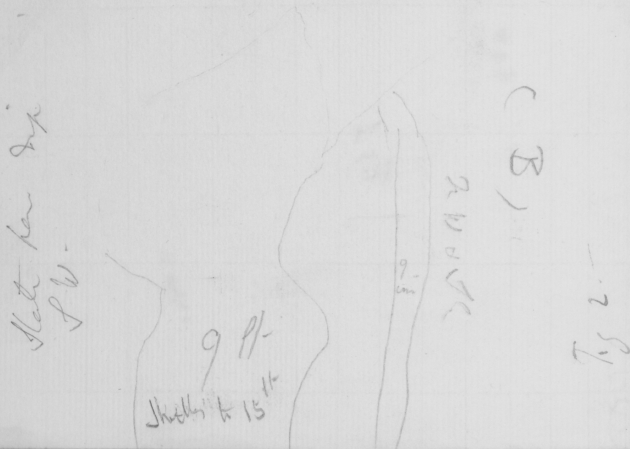
9 ft shells to 15 ft 9 in (B) NW to SE
[page 125]
(C) dyke 18 inches wide — following strata, sudden bulge — D + D reticulated & [on] other part dyke 25 ft: irregular white inside (D). dip of Slate NE — dyke — [run] NW by W compass
[page 126]
E 2 dykes 10 to 20 ft inclined thus upwards also other nearly the same E & W SW compass [Test] [Cony] strata dip 30º — NW by W compass dyke & cleavage
[pages 127-174 blank]
[pages 175-176 excised]
[page 177]
Mellamoy name of four peaked snow mountain S of cone S of Corcovado not known to be volcanic —
Huamlino name of Volcano in S. Pedro
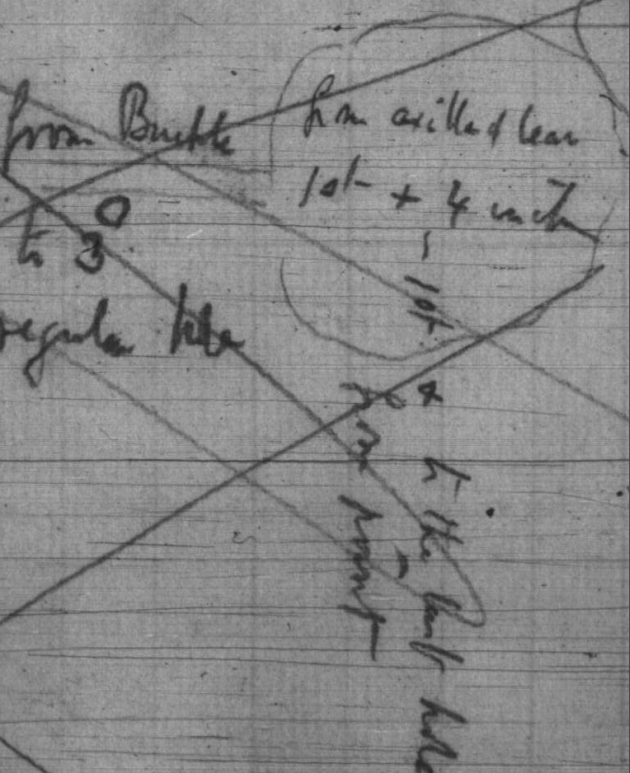 |
[measurement of a plant using his belt]
from Buckle to 3d regular hole1
from axilla of leav 1st + 4 inch
1 of & to the last hole from point
margin of leafe scalloped
|
1 Possibly the Pangi plant. See Beagle diary, p. 272: 'The leaf is much indented in its margin & is nearly circular; the diameter of one was nearly 8 feet (giving a circumference of 24 feet!).'
[page 178]
Different name in diff parts
Chiduco the good sign Huitreu — the bad sign of the Cheucau1 builds its nest in low bushes near the ground: erects its tail like
Tapacola — but comes near to a man if he is quiet. =
Height of [Desiertas Composition]
1 'The cheucau is held in superstitious fear by the Chilotans, on account of its strange and varied cries. There are three very distinct kinds,—one is called "chiduco" and is an omen of good; another, "huitreu" which is extremely unfavourable; and a third, which I have forgotten. These words are given in imitation of its cries, and the natives are in some things absolutely governed by them. The Chilotans assuredly have chosen a most comical little creature for their prophet.' Journal of researches, p. 352. See Pteroptochos rubecula, Birds, p. 73.
[pages 179-180 excised]
[page 181]
Is the brown Vulture found at Shetland?
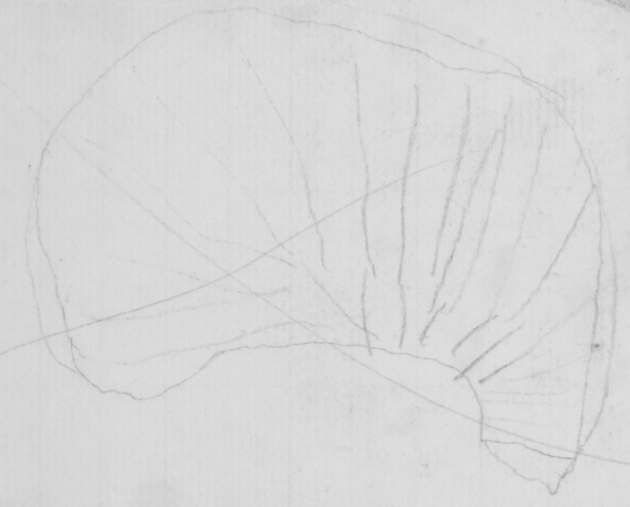
[page 182]
[Barmouth]
[back cover missing]
Textual notes for the Port Desire notebook.
[IFC] C. Darwin] ink.
1.8.] Down House number, not transcribed.
88202328] English Heritage number, not transcribed.
< > [use]...Sound:—] ink.
Pebbles...Coast] ink.
R. Chupat...20'] ink, written perpendicular to the spine.
Calyen 43.10'] written perpendicular to the spine.
7] added by Nora Barlow, pencil, not transcribed. several ink marks appear to be nib tests.
[3] an ink mark appears to be a nib test.
1834] ink.
[4] Plain] ink. (3d)] ink.
[5] Ferruginous...jaspery porphyry] written perpendicular to the spine.
[11] inch] ink.
[18] 144] ink.
[19] ne] ink.
[20] circumference...6 in] circled in pencil and ink.
[23] M. O'Hill: is under 1000 ft.?] ink.
[29] Porphyry...Island.] ink.
[32] Rats...Georgia] ink.
[37] SE....W.)] ink.
[38] two ink marks after 'island' appear to be nib tests.
[39] Tortuous...mechanical. —] ink.
[42] 'N' of 'AN' in ink, second and third 'D' in ink.
[43] page written perpendicular to the spine.
[45-6] pages written perpendicular to the spine.
[46] 9.4...51.4] written parallel to the spine.
[47] page written perpendicular to the spine.
13...40] ink.
5.4...24] written parallel to the spine.
[49] ink sketch written perpendicular to the spine.
[53] Blue leg Vulture. Male.] underscored in ink.
[55] Specimen...build?] ink.
[56] Nov. 1834] not in Darwin's handwriting?
[77-8] leaf excised, now in CUL-DAR35.297A.
[101] [shore]] ink.
[111] sketch perpendicular to the spine.
[112] sketch perpendicular to the spine.
[114] When...from?] ink. 6561.8...2708] calculation written perpendicular to the spine.
[115] page written perpendicular to the spine. [116-17] sketch perpendicular to the spine.
[117] 3 or 4 feet] ink.
Fig. B] ink.
[118] 2700...8005.30] calculations written perpendicular to the spine.
[119] Eruption...Jany] ink.
32808.6.9...12/1.00/0.08] calculations written perpendicular to the spine.
[122] =2800 ft] in ink.
[123] NNW] in ink. Fig. 1] in ink.
[124] Fig. 2] in ink.
[177] from Buckle...4 inch...] written parallel to the spine.
[182] page heavily soiled - indicating where original back cover was once missing. The back cover has been replaced since microfilming.
[Barmouth]] written perpendicular to the spine.
[The Beagle field notebook identifiers were re-set in January 2021 meaning the page counters were reset to 0. At that time this notebook had 12278 visits.]
 REVISION HISTORY: Scanned by Historic England. Transcribed from microfilm by Gordon Chancellor, transcription typed by Kees Rookmaaker 2.2007, corrections by Chancellor, corrections and editing by John van Wyhe 3.2007. Checked against the manuscript by Chancellor 4.2008. Corrected against the microfilm and photographs by John van Wyhe 8.2008. Further corrections against the manuscript by Chancellor 10.2008. Transcription revised and edited by van Wyhe 11-12.2008, 8.2009, 2024. RN24
REVISION HISTORY: Scanned by Historic England. Transcribed from microfilm by Gordon Chancellor, transcription typed by Kees Rookmaaker 2.2007, corrections by Chancellor, corrections and editing by John van Wyhe 3.2007. Checked against the manuscript by Chancellor 4.2008. Corrected against the microfilm and photographs by John van Wyhe 8.2008. Further corrections against the manuscript by Chancellor 10.2008. Transcription revised and edited by van Wyhe 11-12.2008, 8.2009, 2024. RN24



 [gr SN or Hu] S 56 E for the more southerly
[gr SN or Hu] S 56 E for the more southerly [green cy grain] = 15.3 ft R H G F E D (C) (C) (b) (a) (c) ?K a
[green cy grain] = 15.3 ft R H G F E D (C) (C) (b) (a) (c) ?K a 

 [curved strata] & the Southern curvature from anticlinal line: — in a [piece] 4 or 5 feet long & above 3 thick curvature 1/8 of [circle] — plain of divisions forming smooth domes: original however there is much
[curved strata] & the Southern curvature from anticlinal line: — in a [piece] 4 or 5 feet long & above 3 thick curvature 1/8 of [circle] — plain of divisions forming smooth domes: original however there is much  [strata] 20 yards
[strata] 20 yards 






 ∞ 8 5 2 15 8 ft 8 ft
∞ 8 5 2 15 8 ft 8 ft 


 [a frog] Under side1
[a frog] Under side1 [a sea slug] common mantle surpassing inferior Tentac
[a sea slug] common mantle surpassing inferior Tentac [a sea slug] dimension when crawling
[a sea slug] dimension when crawling








 [a hollow concretion]
[a hollow concretion]  NW NE E
NW NE E 
 [diagram of strata?]
[diagram of strata?] 



